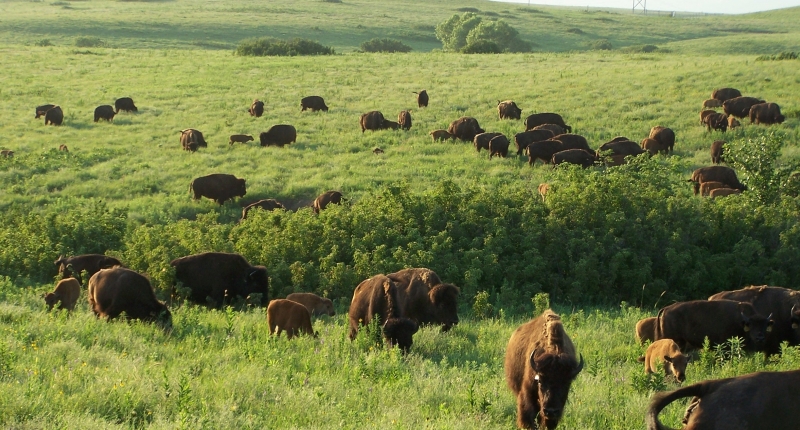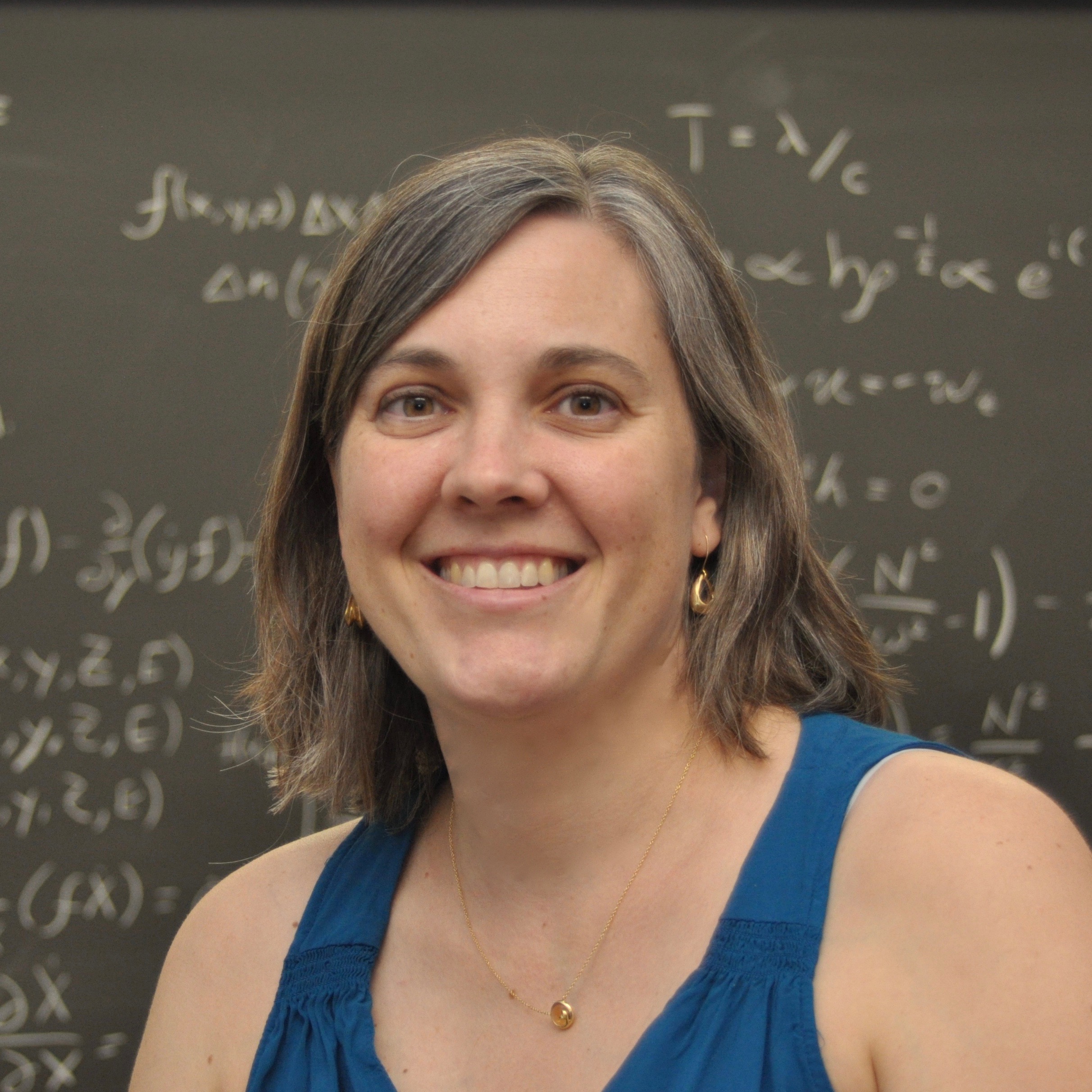NCEAS Portrait: Meghan Avolio Takes the Long View for Plants and People

Meghan Avolio has vivid memories of her first time at Konza Prairie, a research site in Kansas that is part of the Long-Term Ecological Research (LTER) Network. It was her first field season for graduate school, which had entailed a move from New York’s bustling Big Apple to the unofficial Little Apple, Manhattan, KS.
“I found the rolling Flint Hills to be one of the most beautiful places I had been and grasslands to be almost limitless in the number of questions I wanted to answer,” said Avolio, a plant ecologist who is now an assistant professor at Johns Hopkins University.
The questions Avolio seeks to answer are related to how changes at the planetary scale, such as climate change, are altering the communities of plants that make up Konza Prairie and other grasslands across the world, and what those changes could ultimately mean for people and the many benefits, or ecosystem services, we get from plants. Grasslands are not the only backdrop for her research – apropos to her previous city-to-prairie migration, she also applies her questions to urban areas, such as her current hometown of Baltimore.

Avolio is also co-leading an LTER synthesis working group that is trying to get a big-picture perspective on how plant communities are changing worldwide and the consequences for ecosystem services. She and co-lead Kim La Pierre, of Smithsonian Environmental Research Center, have assembled data from 101 relevant long-term experiments into a single database to identify factors of and patterns in these changes.
“Understanding and predicting this change is a big task for ecologists,” she said. “Once the community changes, there may be an associated change in function, but it is difficult to scale site-specific observations to global patterns.”
With their other co-lead Kevin Wilcox, an assistant professor at the University of Wyoming, they are working to scale-up such observations by incorporating the insights from their synthesis into scientific models. This will allow the models to make better predictions of how plant-derived ecosystem services across the globe might change – and how those changes could affect future human well-being.
“We, as humans, have some important decisions to make about the type of environment we want to live in and what we deem suitable – for ourselves, for others, and for the other billions of species we share the planet with. I hope the science I do aids those making the decisions,” said Avolio.
In this month’s NCEAS Portrait, Avolio shares how she thinks long-term research and scientific synthesis can improve how we understand the connections between plants – and between plants and people.
What makes you passionate about plant ecology?
MA: To know the plants is to know a place. Plants are iconic, from the palm trees of Los Angeles to the sunflowers of Kansas. Plants evoke memories and sense of place. At Konza, I love resampling the same plots year after year and learning which species are persisting, who is moving on, and who is new to the area. It is always changing and challenging.
How does long-term ecological data and synthesis science support your research?
MA: Plant communities take time to change, and many of the changes that occur take several years to develop, much longer than the typical ecological study. Long-term data is essential to gain insights into these complex changes. Often, trends that are observed in the first few years of an experiment disappear, demonstrating this complex nature. Of the several experiments I am involved in at Konza prairie, all are long term (5 years or longer). What fascinates me is that, even in the 16th year of an experiment, we are observing new patterns and coming up with new research questions to ask.
Some of your work is in collaboration with social scientists. Why do you feel these interdisciplinary collaborations are important?
MA: For my urban work, I collaborate with social scientists to better understand the preferences of city residents for urban plants. We send out surveys and give interviews asking residents about the plants in their yard, neighborhood, and city. Since cites are designed for humans, it is important to know what people want for urban vegetation to better understand patterns of urban biodiversity and to make suggestions for more livable cities.
For some ecological pursuits, social science is integral; however, for others, it is not as necessary. For example, in our [LTER] synthesis work, it is not necessary to have a social science perspective – we are trying to understand patterns of plant community change. But in any research where the outcome is the management of resources, I do think it is necessary to understand the social perspectives involved. My time at the National Socio-Environmental Synthesis Center (SESYNC) gave me a great appreciation for how much ecological research can benefit from the integration of social sciences, including economics, sociology, anthropology, and history. Some fields, such as political ecology and geography, have a rich history of excellent socio-ecological research that I think ecologists should look to as a starting point.
What kind of impact do you hope your LTER research will have?
MA: I hope my research will assist with analyzing patterns of community change in both observational and experimental studies. With long-term datasets, there are many complex ways communities can change over time. To assist with analyses, my colleagues and I recently released an update to the “codyn” R package [a set of statistical tools for analyzing plant community dynamics]. Our new functions focus on which species are in a community and how abundant they are. It was very humbling to update an R package, because it was so outside my comfort zone, but also exciting to think about making analyses easier for ecologists and to expand how we study communities beyond the traditional richness and diversity metrics.
What value does your LTER synthesis research bring to you personally?
MA: The LTER program has had a strong impact on the type of scientist I am and the types of questions I ask. It was a long-term nutrient experiment at Konza that had given me and Kim [La Pierre] the original idea for our first synthesis working group six years ago. After talking with colleagues at other LTER sites, we all realized we were observing similar patterns of community change in very different ecosystem types. This inspired us to apply for funding, which we first got in my last year of graduate school, and what started as side project has evolved into an integral part of my research program. This work has put me in touch with ecologists around the globe; has drastically improved my data management, coding, and analytical skills; and has inspired countless research questions for me.
What is an important lesson you’ve learned from your synthesis work?
MA: Keep data in long format, not wide! Everyone makes mistakes. It is best to write scripts and have code for most of the data manipulation. In other words, stay away from excel. Ultimately, for me and Kim, our goal is to have all of our data cleaning, collating, and analyses be repeatable. This will make our work more transparent and easier for others to build upon.
# # #
Learn more about the LTER synthesis working groups.
NCEAS Portraits feature the people behind our work and impact.
